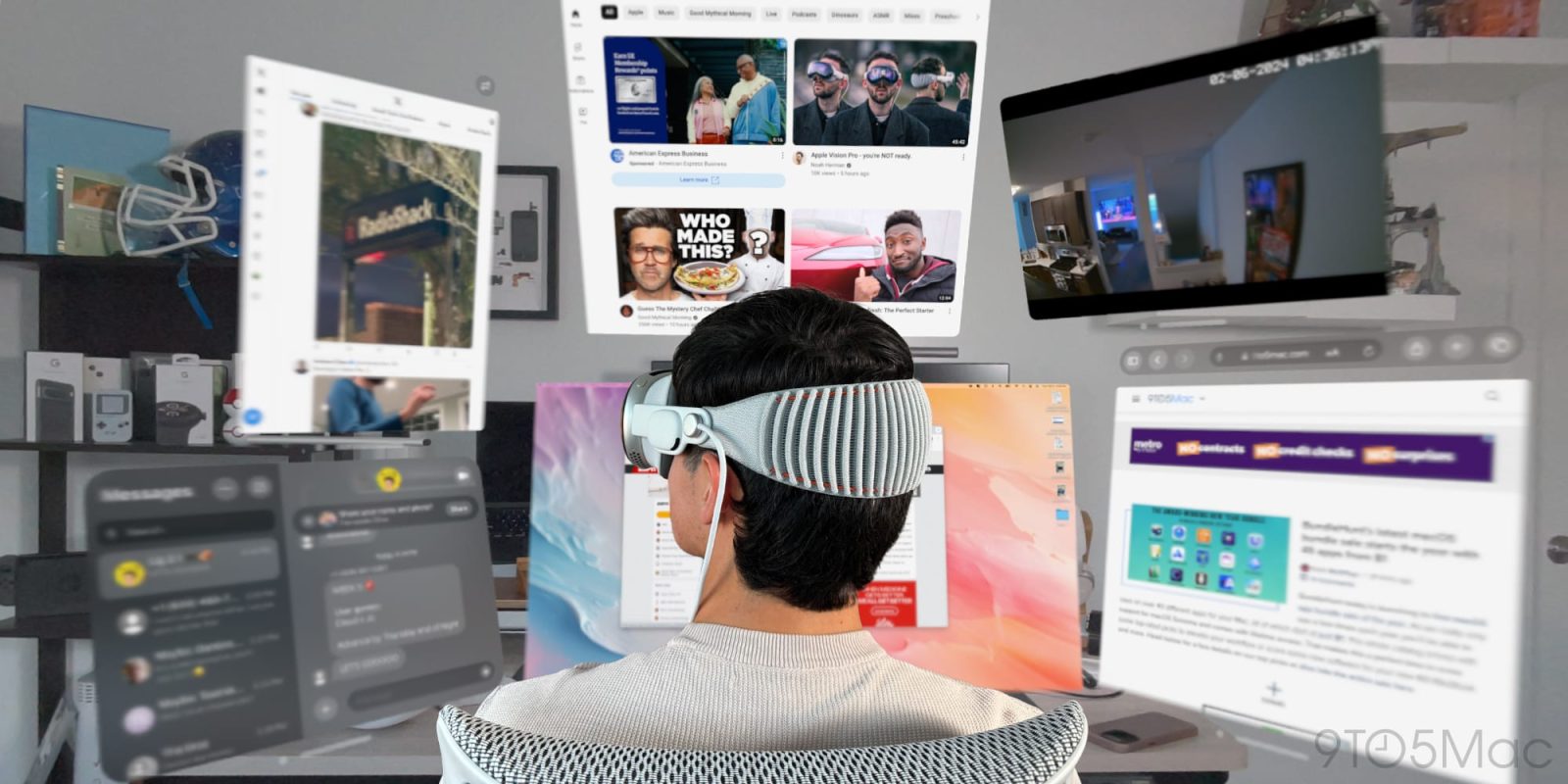
Perhaps the primary question to be answered regarding Apple’s new spatial computer is: What is it for? And the bigger version of that question: Is Vision Pro a first step toward the future of computing?
Right now, in a world where relatively few people have even tried it, and even fewer of them have bought it, it’s clear that there’s nothing remotely approaching a consensus. Answers range from “Of course not, it’ll just be a short-lived gimmick” to “Absolutely, this will replace our Macs” …
It’s not about this device
As a Brit, I can’t even try a Vision Pro yet, but I have at least been able to get a sense of this type of experience. I’ve used $6,500’s worth of combined VR/AR headset at one end of the scale, and $439’s worth of ‘external monitor in glasses form factor’ at the other – and the two of them have rather more in common than I would ever have guessed.
I’ve also watched a lot of Vision Pro reviews, and watched a lot of videos, to get a rough feel for the UI, its strengths, and its weaknesses.
None of that qualifies me to pass judgement on Vision Pro as a device, of course, but that’s not the issue we’re addressing here. The question is not whether this specific device is the future of computing – that one is easy to answer; it’s definitely not.
The question is whether future iterations of a head-worn device will at some point replace Macs and PCs as our primary computing devices.
Because we’re addressing that broader question, none of the criticisms of Vision Pro as it stands today are relevant. It’s too heavy. The center of gravity is too far forward. The app management is clunky. The hunt-and-peck keyboard experience isn’t usable. The passthrough isn’t good enough. And so on.
There’s enough consistency to those sorts of complaints that I have no doubt they are true – but this is a first-generation device. We have to view this as the equivalent of an original iPhone from 2007. If we were reviewing this today, we’d be appalled at the microscopic screen, the painfully slow data, the lack of apps, and so on. But that device turned into the most popular phone in the world.
The future is (probably) Apple Glasses
Currently, there isn’t the slightest chance that Vision Pro will replace a Mac, for a whole range of reasons.
But now let’s imagine replacing that clunky headset spatial computer with something looking and feeling much closer to a standard pair of eyeglasses. Viture and others have already demonstrated an ability to get remarkably close to this, albeit with the computing power delivered by an external device.
Imagine it with the power of a MacBook Pro:
- Same performance
- Same multi-monitor capabilities
- Same battery-life
- Same touch target precision thanks to improved hand detection
Ok, maybe we still need a physical keyboard for writing. But for tasks which require only limited text input, perhaps it would be enough to map a keyboard to the coffee-shop table surface in front of me, and using Apple Watch haptics to help me locate the home keys.
Could this be a device which replaces a MacBook?
I’m tending toward ‘yes’
It’s very early days for this type of tech, and there are a huge number of unknowns. But right now, I can say two things.
First, anyone who argues that we’ll never manage to squeeze the power of a MacBook Pro into a pair of sleek, lightweight glasses is on the wrong side of tech history. This thing right here?

That’s an IBM 305 unit – a 5MB (not GB) hard drive – from 1956. It weighed over a tonne, and cost more than half a million dollars in today’s money. Today, I have 6,000 times as much storage on a $30 USB key sitting on my keychain. The question here is when, not if.
Second, I’m already personally sold on the glasses form factor for at least some applications.
A few weeks ago, I finally managed to come up with an excuse to buy an iPad mini – for watching movies in bed. My 12.9-inch iPad screen was way too big and heavy for comfortable viewing, and my iPhone 15 Pro Max screen was too small. Thankfully I bought a used one, and will be able to sell it for the same price I paid – because I haven’t touched it since I got the Viture One glasses. Having an 80-inch screen I don’t even have to hold is an unmistakably superior solution.
Similarly if I want to watch movies on trains and planes. My solution used to be my 12.9-inch iPad Pro; next trip, I’m certain it will be Viture One.
When it comes to work, I’m already pretty sure I’d want a glasses-format MacBook Pro for travel use, and I think I may even want one for home use too. I adore my 49-inch monitor, but if I could have that in a device I can pick up and put into a drawer at the end of my working day … It’s a pretty strong argument for anyone who works from home but doesn’t want to see an office environment when they’re not working.
I said earlier that the $6,500 Varjo XR-3 and the $439 Viture One had way more in common than I expected, and that’s because despite the glasses having some tiny fraction of the capabilities of the headset, my key takeaway from each was the sense of immersiveness. It’s a very compelling thing, even in the simple case of watching a movie or playing a game.
Maybe Apple Glasses won’t be a complete replacement for a Mac. Maybe they won’t be a replacement for everyone. But for a lot of the people, for a lot of the time? I suspect the answer is yes. What say you?
FTC: We use income earning auto affiliate links. More.




